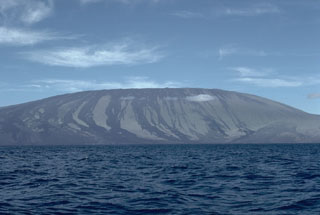Report on Wolf (Ecuador) — August 1982
Scientific Event Alert Network Bulletin, vol. 7, no. 8 (August 1982)
Managing Editor: Lindsay McClelland.
Wolf (Ecuador) Lava fountaining and flows in caldera and on SE flank
Please cite this report as:
Global Volcanism Program, 1982. Report on Wolf (Ecuador) (McClelland, L., ed.). Scientific Event Alert Network Bulletin, 7:8. Smithsonian Institution. https://doi.org/10.5479/si.GVP.SEAN198208-353020
Wolf
Ecuador
0.02°N, 91.35°W; summit elev. 1710 m
All times are local (unless otherwise noted)
Eruption clouds began to emerge from the volcano during the afternoon of 28 August. Plume emission was first detected on visible band satellite images between 1300 and 1400, and feeding continued until nightfall. The plume, which drifted W, could not be seen on infrared imagery, indicating that it remained at low altitudes. Observers on a tour ship first saw clouds issuing from the summit about 1430-1500 and reported strong summit glow that night. Activity on the SE flank was first observed at 0830 the next morning, but heavy weather clouds had obscured this area the previous afternoon, and flank vents may have been active then as well.
Tui DeRoy Moore and others arrived at the SE flank late 31 August. Lava fountained from a radial fissure that extended 1 km or more downslope from 875 m altitude. Fresh lava covered the area near the fissure. Lava flowed SE then turned toward the E, reaching about 280 m altitude. This flow had stopped advancing by 1 September and fountaining had ended by that evening, although some SE flank glow remained visible. As the flank activity declined, summit activity increased. Summit glow had been visible since 28 August, but strengthened during the night of 1-2 September and a large convecting cloud was present over the caldera. Moore reached the caldera rim on 3 September and found several vents active in the caldera, the strongest on its floor at the base of the steep SW wall. Lava fountaining from this vent was continuous and the fountains occasionally rose as high as the caldera rim, approximately 700 m above the floor. Intermittent, relatively weak fountaining (less than 50 m estimated height) occurred from four small vents along a 100-200-m-long fissure on the S caldera floor. Thick-looking pahoehoe lava covered slightly more than half of the caldera floor, or approximately 6 km2, and was mainly on the N and NW side. Gases emerging from the base of the convecting eruption cloud formed a haze that drifted W, away from the observers. By early 4 September, when Moore left the volcano, a cone had begun to form around the main vent. Activity appeared to be dominated by scoria ejection, with little lava being added to the caldera floor flows. No earthquakes were felt by the observers, and Moore reported that there seemed to be little effect on the flora and fauna. Glow was still visible in the eruption cloud late 5 September and airplane passengers saw a strong plume 6 September.
Wolf has been one of the more active Galápagos volcanoes. Flank eruptions from the same SE vent area took place in 1948 and 1963, but summit caldera activity had not been documented since 1800. A probable SE flank eruption was heard but not seen in 1973. The present eruption is a two-hemisphere event, with the caldera lying mostly N of the equator and the SE vent, less than 10 km distant, in the Southern Hemisphere.
Further Reference. Schatz, H., and Schatz, I., 1983, Der ausbruch des Vulkanes Wolf (Inseln Isabela, Galápagos-Inseln Ecuador) im Jahre 1982—Ein Augenzeugenbericht; Ber. Nat. Med. Verein Innsbruck; v. 70, p. 17-28.
Geological Summary. Volcán Wolf, the highest volcano of the Galápagos Islands, straddles the equator at the north end of the archipelago's largest island, Isabela. The edifice has steeper slopes than most other Isabela volcanoes, reaching angles up to 35°. The summit caldera is 6 x 7 km across and 700 m deep. A prominent bench on the west side of the caldera rises 450 m above the caldera floor, much of which is covered by a lava flow erupted in 1982. Radial fissures concentrated along diffuse rift zones extend down the N, NW, and SE flanks, and submarine vents lie beyond the N and NW fissures. Similar unvegetated flows originating from a circumferential chain of spatter and scoria cones on the eastern caldera rim drape the forested flanks to the sea. The proportion of aa lava flows exceeds that of other Galápagos volcanoes. An eruption in in 1797 was the first observed and documented in the Galápagos Islands.
Information Contacts: T. Moore, Isla Santa Cruz, Galápagos.

